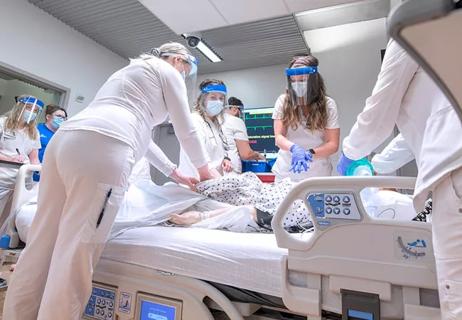Critical care nurses at Cleveland Clinic Avon Hospital have harnessed a simple yet effective communication tool to help them guide patients to articulate their wishes for end-of-life care. Their efforts have allowed them to better lead the way during an anxious, stressful time for patients and caregivers.
Cleveland Clinic is a non-profit academic medical center. Advertising on our site helps support our mission. We do not endorse non-Cleveland Clinic products or services. Policy
During an eight-week introduction of the PULSES tool in the hospital’s ICU in 2019, the percentage of critical care patients with code designations on file rose from 36.6% to 75.6%.
The system was introduced at the hospital by Doris Patrick, DNP, ACNP. With more than 20 years of experience as an acute care nurse, Patrick knows the challenges presented by the need to make EOL care decisions in a quickly shifting landscape. “Taking care of patients many times results in changing the health care plan from doing everything possible — with technology, CPR or life support — to recognizing that this patient is now at the end of their life,” Patrick says.
Whether that transition happens gradually or turns in a moment, patients ultimately are best served when they have the opportunity to discuss critical factors. “Having those conversations with families and patients is so important,” Patrick says, “and saying the right words to families can make a difference in code status designations.”
It can be especially difficult for patients to face these important questions when they are feeling stressed, rushed or sick. ACNPs and intensivists are responsible for initiating the discussions, but they may not have been trained to conduct them comfortably or to cover all of the relevant points.
“We all want to do it better,” Patrick says.
As a veteran of patient care, Patrick was passionately interested in elevating the experience for patients and for the nurses dedicated to their care. She introduced PULSES as a quality improvement initiative.
Patrick searched literature for practices that could be introduced in an intensive care setting. The PULSES Project, developed in 2017 by Canadian oncologists, was an evidence-based model well suited for the ICU.
The PULSES acronym sets forth the six steps of the communication framework:
At Avon Hospital, ACNP patient-care responsibilities include admission assessments, patient resuscitations, and leading goals-of-care discussions for chronically and critically ill patients. Those discussions begin with helping patients and families understand the prognosis, Patrick explains.
“We talk about what their disease process is and what we think their outcome is going to be,” she explains.
“The next thing is to help them consider their underlying values. What’s important to the patient? What’s important to the family?”
Active, compassionate listening is key, Patrick adds. “If we were just spouting information, that wouldn’t help.”
In addressing long- and short-term outcomes of resuscitation, patients may need details they might not have considered on their own: that CPR could result in a broken rib or punctured lung, for example, or that temporary oxygen deprivation might result in reduction of brain function. Understanding the risks and complications associated with resuscitative measures help patients arrived at informed consent.
The PULSES “educator recommendation” step is the point when the professional caregiver offers guidance. “The practitioner has not only the ability, but the responsibility to tell the family what the recommendation is,” Patrick says.
The last step calls for summarizing the patient’s decision and documenting code directives and wishes.
Patrick developed a 15-minute slide presentation to educate ACNPs, including float nurses, who were scheduled to work in the ICU during PULSES implementation. She also made herself available to answer any questions throughout the rollout. Nurses received a pocket card to remind them of the steps.
“The year before we started this, I was involved in a study where we looked at who had code status designations and who did not. And after I did my study with PULSES, our results show that we had an increase from about 36 percent to 74 percent,” Patrick says. “Having that conversation up front, and getting their idea of what they want, helps us tremendously.”
As time goes by, fundamentals of the tool may need to be reinforced, but she believes caregivers appreciate having a standardized guide for conducting EOL conversations.
“Some of them might have already been using maybe one step or two step, but it’s helpful to put it all together,” Patrick says. “The research shows that if you use all of these steps, you’re more likely to have an effective discussion resulting in a code status designation.”

Leadership rounds educate nurses and foster teamwork

Veteran nurse shares his experience as a caregiver and community volunteer

Decision tree amplifies commitment

Hospital earns nine exemplars from the Magnet Recognition Program®

Supporting newly graduated RNs before and after the pandemic

Creating a roadmap to get everyone on board

SHINE program is seeing results

From transformational leadership to empirical quality results